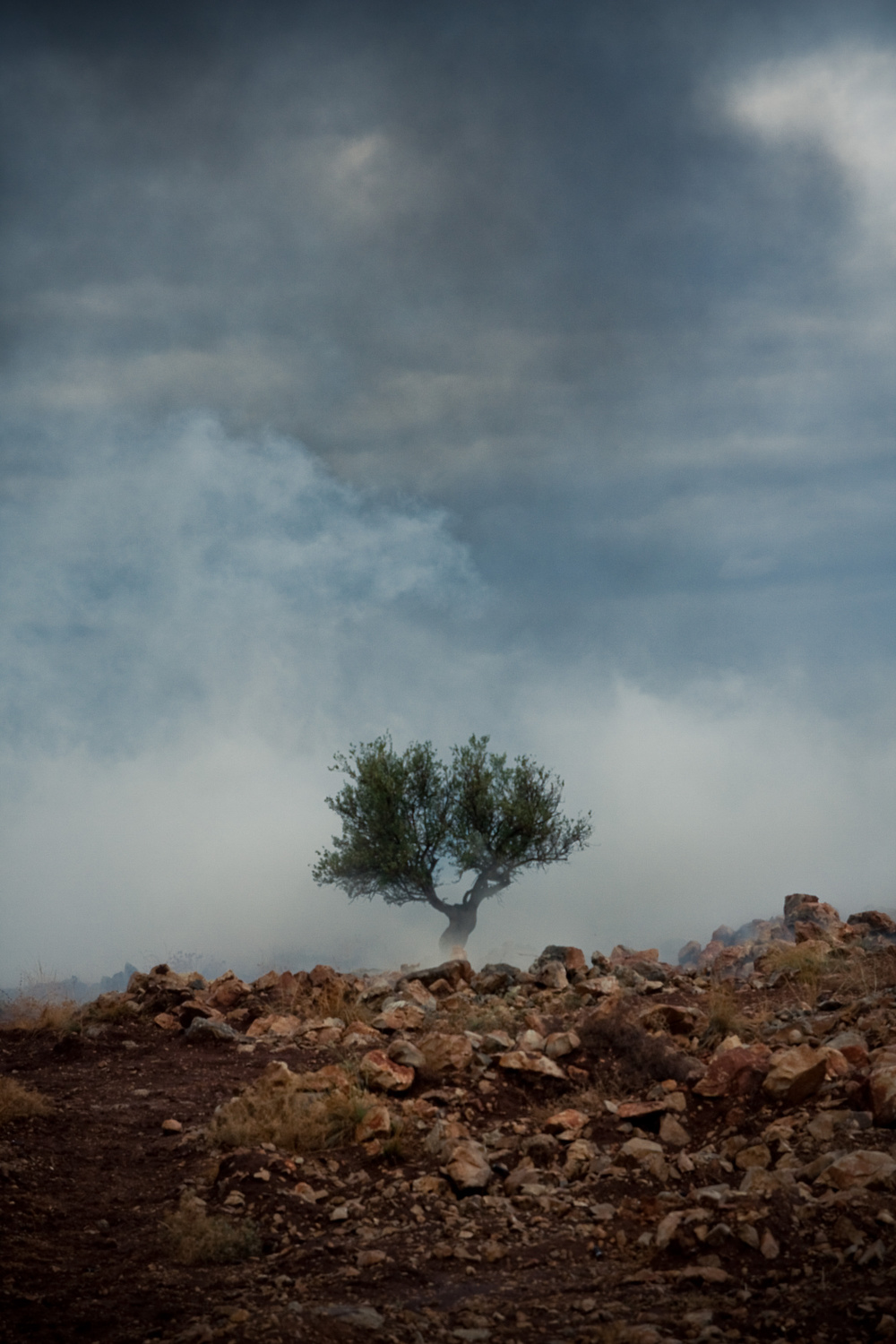
October. 30, 2009 - Ni'lin, West Bank. A lonely olive tree stands under the rain. Like every Friday, inhabitants of the village protest against Israel's security wall that crosses through their agricultural lands. Up above, a dark sky fills up with black smoke from a fire, lit by Palestinian protesters at the bottom of the wall. Down bellow, tear gas, used by the Israeli army to scatter the crowd, rise up. The olive harvest in the West Bank used to be a joyful time, but, for the past years, it rhymes with violence. Israeli media now refers to it as, the ÇOlive WarÈ.

October, 16. 2009 - Yanoun, West Bank. Walid harvests olives in the family field, with the help of his brother Jafar. Most of the harvest will be sold to an olive oil cooperative, and the family will use the rest. Walid remembers, ÇA few years ago, the settlers cut the trunks of more than 200 trees. One day they shot my uncle. A bullet in the leg just because he was picking olives in his field, too close to the settlement.È

October, 21. 2009 - Burin, West Bank. Meagre harvest for Abed Al-Muhainin. ÇDuring the night of Yom Kippur, he recounts, 25 settlers came down from Yitzhar village and cut the branches of 97 olive trees after trying to burn them.È

October, 16. 2009 - Yanoun, West Bank. According to the Red Cross, in 2009, more than 100,000 families depend to some extent on the roughly 10 millions Palestinian olive trees, producing 20,000 tons of oil every year.

October, 16. 2009 - Yanoun, West Bank. According to the Washington Post, olive tree fields occupy 40 % of the agricultural lands, and generate an earning of 120 million US$. An amount that could double if exporting was made easier.

October, 21. 2009 - Burin, West Bank. Since 2000, Israeli NGOs such as Rabbis for Human Rights and the Association for Civil Rights in Israel have denounced the violent acts committed by settlers during the olive harvest, a key period for the economy of Palestinian villages.

October, 21. 2009 - Burin, West Bank. According to the Israeli police, an average of 500 ÇfrictionÈ between farmers and settlers are recorded every year in the West Bank. Only few of the 121 Israeli settlements are blamed in these actions that involve the most extreme and conservative settlers.

October, 21. 2009 - Burin, West Bank. Abed Al-Muhainin surveys his devastated land. Since the Oslo Accords, signed in 1993, West Bank has been divided in three zones. Zone A is under Palestinian civil jurisdiction. Zone B is under a shared Israeli Palestinian control, and zone C is totally controlled by Israel. Zone C represents 71 % of the territory, especially around Israeli settlements and roads leading to them.

October, 21. 2009 - Yitzhar, West Bank. Funded by a group of orthodox Jews in 1984, the settlement established itself only a few miles away from the Palestinian village of Burin. ÇThis earth is a gift from god to the Jewish people. We received it to accomplish Torah.È, comments Ariel Benchetrit, a settlers interviewed by the French magazine ÇLa CroixÈ. Started in the seventies, the construction of Israeli settlements is considered contrary to the Geneva Convention by a large part of the international community, the UNO, as well as the International Court of Justice. Motivations to build settlements are varied : land given by God for some, historical area for others, the settlements also offer houses and services for a very low cost.

October, 16. 2009 - Yanoun, West Bank. A group of Israeli soldiers evacuates foreign volunteers and journalists from a Zone C field where Walid is harvesting his olives. Since Zone C was created, along roads and settlements close to Yanoun, Walid and his family can't access part of their lands. ÇEach year, we have to ask for a special permit to the Israeli army to access Zone C, and harvest our olives. We would need 13 days to complete the harvest, but we are not granted more than three days. After that, settlers come down and pick up the rest. Some years, the army doesn't even deliver permits. If we try to go outside of these periods, settlers attack us.È

October, 16. 2009 - Yanoun, West Bank. Around mid October 2002, recounts Benjamin Barthe, Radio France Internationale foreign correspondent, Çfrightened by the regular attacks from Itamar's settlers, [É], the 150 inhabitants [of Yanoun Village] left their homes to seek refugee in Aqrabah. Yanoun then became a ghost town for a few days.ÈSince then, access to the fields happens under strict supervision by the Israeli army. Day after day, trees become sick, as they lack proper care, and eventually become unproductive. The process thus forces farmers to abandon their lands.

November, 20. 2009 - Ni'lin, West Bank. A young Palestinian boy, armed with a slingshot, throws a stone towards an Israeli army vehicle. In the background, beyond the Israeli security wall, lies the Ma'ale Adumim settlement. In the village, weekly protests started after the Israeli Higher Court of Justice recognized that the security wall, south of the village, encroached Palestinian agricultural lands, and should be moved to its right place, more than a mile west.

November, 20. 2009 - Ni'lin, West Bank. ÇToday, Mr. President, I have come bearing an olive branch and a freedom fighter's gun. Do not let the olive branch fall from my hand.È Yasser Arafat. UNO speech, November 13th 1974. Under the olive tree, a hooded protester prays on his knees. An unexploded tear gas canister, thrown by the Israeli army, hangs from his belt.







































